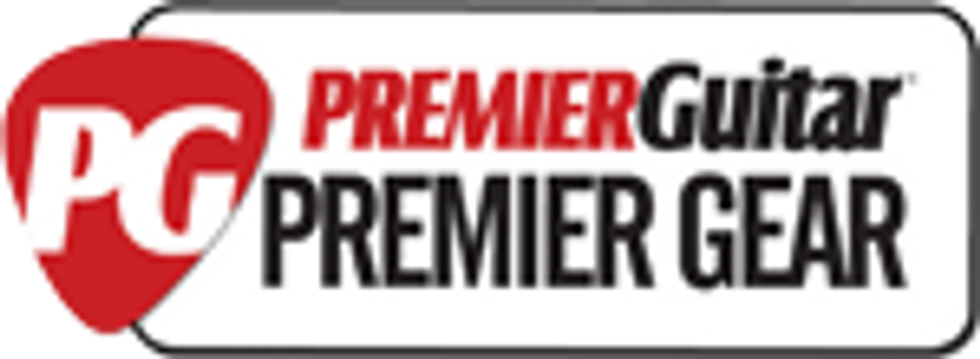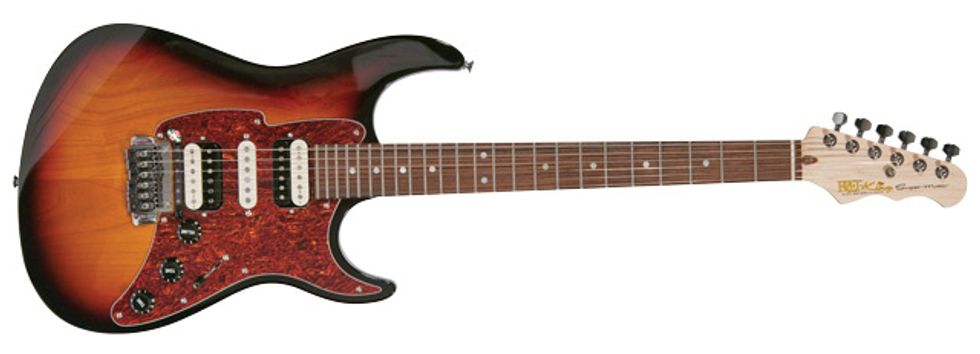Listen:
 In a recent Rig Rundown on premierguitar.com, Black Crowes and North
Mississippi All Stars guitarist Luther
Dickinson called tuning a “microsecond
to microsecond battle.” For many pitch-obsessive
players, that isn’t far from the
truth. And if you’re a tuning freak who
switches between tunings and guitars in
performance? Well, that can add up to a lot
of variables—and stress—pretty quickly.
In a recent Rig Rundown on premierguitar.com, Black Crowes and North
Mississippi All Stars guitarist Luther
Dickinson called tuning a “microsecond
to microsecond battle.” For many pitch-obsessive
players, that isn’t far from the
truth. And if you’re a tuning freak who
switches between tunings and guitars in
performance? Well, that can add up to a lot
of variables—and stress—pretty quickly.The dream of a self-tuning system has probably been around as long as the electric guitar itself. And the Fret-King Super-Matic reviewed here is not the first guitar to attempt the feat. But in terms of ease of use and versatility, the Super-Matic may be the most elegant and practical stab at a self-tuning system yet.
From the Mind of a restless Innovator
Trev Wilkinson, the brains behind the Super-Matic, has been tinkering with electric guitar design for decades, and his hardware innovations are among the more lasting developments of the last 30 years. His Wilkinson roller nut, which caught the guitar playing public’s eye as a feature on Fender’s Strat Plus in 1987, remains widely used and influential. And his locking tuners and bridges are go-to parts for guitarists improving and modifying their stock instruments. Wilkinson probably could rest on his laurels at this point. But as his ongoing work with the Fret-King and Vintage brands attests, Wilkinson sees room for innovations— big and small—in even the most iconic electric guitar designs.
On the surface, there’s little hint of what this guitar can do. The heart of the self-tuning system is the Wilkinson ATD HT440 bridge, which is conventional enough looking at first glance, but upon closer examination reveals itself to be a little engineering marvel. Just aft of each fully adjustable saddle there’s a capstan that anchors the string. Each capstan is attached to an individual motor and gearbox. The motor and gear box assembly interface via a microprocessor with a hex pickup just forward of the bridge and a tuning selector for accessing presets.
The interface between player and the tuning selector is itself quite unobtrusive. There’s a very small (and at first easy-to-miss) button mounted on the treble side of the pickup, and on the bass side, a small oval LCD readout that relays simple data about preset selection, whether a note is sharp or flat (when the built-in chromatic tuner is in use), and system status alerts for broken strings, battery life, and partial tuning. The entire system runs on a 9-volt battery, which Fret-King says will last for up to 250 tunings.
The guitar itself is a handsome, modern twist on a Strat profile. The two-piece alder body has a reassuring heft—particularly with all the onboard electronics— but could benefit from a few smoother body contours at the body edges, which will occasionally give you a jab in the ribs. The 25 1/2" scale neck with rosewood fretboard and medium-jumbo frets is basically a comfy slim C shape, if a little bit flattish for my tastes.
The guitar’s standard electronics include Wilkinson WHHBZ33 offset pole piece “Zebra” humbuckers and a Wilkinson WHSM single-coil in the middle position. They’re wired via a 5-position selector switch and Wilkinson ’s Vari-coil system which enables variable splitting using the aft-most tone control, which is arguably a less clumsy and tonally varied approach than push-pull pot coil tapping.
Tuning on the Fly
The Wilkinson ATD HT440 bridge isn’t totally intuitive if you’re new to the technology, but it’s a very streamlined system with a minimum of controls that’s easy to get a feel for—especially if you treat yourself to a video tutorial from Wilkinson himself on the Fret-King web site (fretking.com). Once you grow accustomed to using the master function button (which doubles as an on/off switch and preset selector) and learn the symbols and preset numbers displayed on the LCD, the ATD HT440 works almost as naturally as a pedal tuner.
Factory presets include standard EADGBE, Drop D, Open G, Open E, DADGAD and GDFCDG. And setting up the Super-Matic for any one of them is a simple process of holding the function button down until the number 1 appears, clicking the button repeatedly until you find the number that corresponds to the desired preset, and strumming once. You’ll hear a quick burst of activity from the miniature motors in the bridge as they turn the capstans, and if you have the guitar’s volume up, the odd sound of the strings changing pitch in unison. Occasionally it will take a second slow strum for the system to read, process, and retune each note, but it rarely takes a third strum if you’re patient and deliberate.
One of the coolest aspects of the Super-Matic is the ability to store your own tunings, which is also a straightforward, if slightly more complex process called Strum ’N’ Store. You have to find and dial in the tuning yourself using the onboard chromatic tuner. But once you have the tuning in place, you hold the button for 10 seconds to unlock the ATD HT440 system, scroll to the preset number you want to use and strum the strings. Once a green light on the LCD confirms that the tuning is stored, you depress the button for another 10 seconds to re-lock the system.
There are limitations to Strum ’N’ Store. There’s a two-step pitch range limit in both flat and sharp directions for each string. So players who favor low tunings that drop the 6th string to C, for instance, won’t be able to use the preset function. The capstans can also only handle a maximum string thickness of .011 on the 1st string and .052 on the 6th, which covers most players, but leave some heavy-string fans and slide players who like fatter wire out of the mix.
No matter what the tuning, the Super- Matic has the tone-shaping potential to get the most out of it. The combination of the Vari-coil system and the 5-position switch puts a lot of sonic flavors at your fingertips. Running the Super-Matic straight into a Vox TB35C2 Bruno and a Fender Vibroverb, DADGAD and open G tunings growled aggressively and brimmed with harmonics, especially through the hot bridge humbucker. Rolling off the Vari-coil control and splitting the bridge humbucker gave the DADGAD setting a quieter, but crystalline quality that highlighted harmonic detail, while open G chords kicked with snappy Keith Richards sass.
The Verdict
The Fret-King Super-Matic does a truly impressive number of things for a single guitar, which should be little surprise given the creative record of its creator. None of the Super-Matic’s features reek of gimmickry, though. The ATD HT440 system is smooth and intuitive once you take a few minutes to acquaint yourself with its rhythms and commands. And the Vari-coil electronics and triple-pickup array give you a million ways to highlight the harmonic advantages of each tuning. A lot of guitars claim to be a guitar for every performance situation. Such an animal may never really exist, but the innovative, high-quality, super-playable, and ultra-versatile Fret-King Super-Matic comes pretty close.
Buy if...
hauling multiple guitars for alternate tunings to gigs wears you out.
Skip if...
you have little trust in guitar innovations past the development of the Telecaster.
Rating...
Street $1599 - Fret-King - fret-king.com |














![Rig Rundown: Russian Circles’ Mike Sullivan [2025]](https://www.premierguitar.com/media-library/youtube.jpg?id=62303631&width=1245&height=700&quality=70&coordinates=0%2C0%2C0%2C0)




